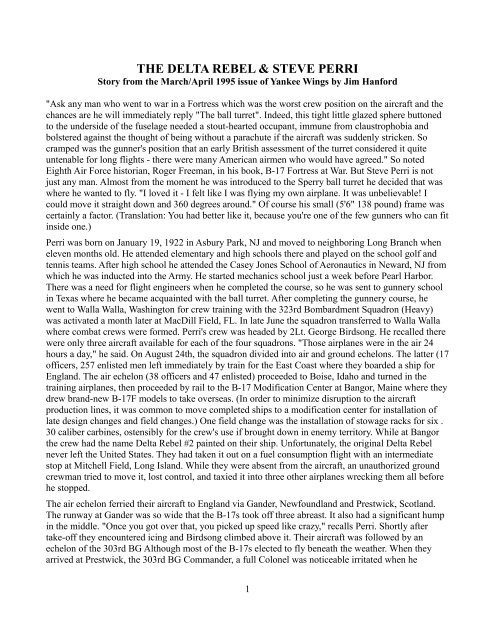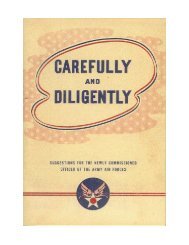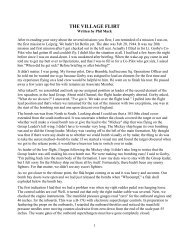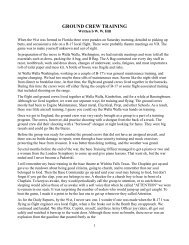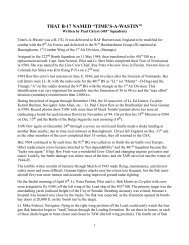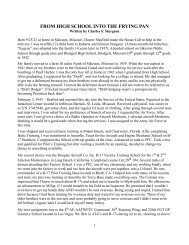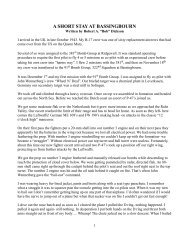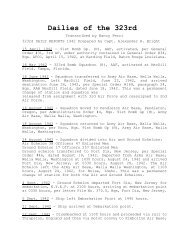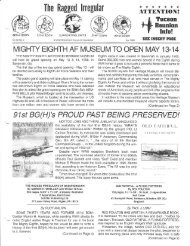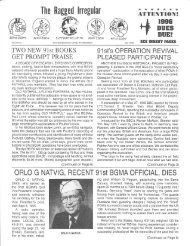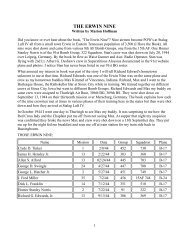THE DELTA REBEL & STEVE PERRI - the 91st Bomb Group!
THE DELTA REBEL & STEVE PERRI - the 91st Bomb Group!
THE DELTA REBEL & STEVE PERRI - the 91st Bomb Group!
Create successful ePaper yourself
Turn your PDF publications into a flip-book with our unique Google optimized e-Paper software.
<strong>THE</strong> <strong>DELTA</strong> <strong>REBEL</strong> & <strong>STEVE</strong> <strong>PERRI</strong><br />
Story from <strong>the</strong> March/April 1995 issue of Yankee Wings by Jim Hanford<br />
"Ask any man who went to war in a Fortress which was <strong>the</strong> worst crew position on <strong>the</strong> aircraft and <strong>the</strong><br />
chances are he will immediately reply "The ball turret". Indeed, this tight little glazed sphere buttoned<br />
to <strong>the</strong> underside of <strong>the</strong> fuselage needed a stout-hearted occupant, immune from claustrophobia and<br />
bolstered against <strong>the</strong> thought of being without a parachute if <strong>the</strong> aircraft was suddenly stricken. So<br />
cramped was <strong>the</strong> gunner's position that an early British assessment of <strong>the</strong> turret considered it quite<br />
untenable for long flights - <strong>the</strong>re were many American airmen who would have agreed." So noted<br />
Eighth Air Force historian, Roger Freeman, in his book, B-17 Fortress at War. But Steve Perri is not<br />
just any man. Almost from <strong>the</strong> moment he was introduced to <strong>the</strong> Sperry ball turret he decided that was<br />
where he wanted to fly. "I loved it - I felt like I was flying my own airplane. It was unbelievable! I<br />
could move it straight down and 360 degrees around." Of course his small (5'6" 138 pound) frame was<br />
certainly a factor. (Translation: You had better like it, because you're one of <strong>the</strong> few gunners who can fit<br />
inside one.)<br />
Perri was born on January 19, 1922 in Asbury Park, NJ and moved to neighboring Long Branch when<br />
eleven months old. He attended elementary and high schools <strong>the</strong>re and played on <strong>the</strong> school golf and<br />
tennis teams. After high school he attended <strong>the</strong> Casey Jones School of Aeronautics in Neward, NJ from<br />
which he was inducted into <strong>the</strong> Army. He started mechanics school just a week before Pearl Harbor.<br />
There was a need for flight engineers when he completed <strong>the</strong> course, so he was sent to gunnery school<br />
in Texas where he became acquainted with <strong>the</strong> ball turret. After completing <strong>the</strong> gunnery course, he<br />
went to Walla Walla, Washington for crew training with <strong>the</strong> 323rd <strong>Bomb</strong>ardment Squadron (Heavy)<br />
was activated a month later at MacDill Field, FL. In late June <strong>the</strong> squadron transferred to Walla Walla<br />
where combat crews were formed. Perri's crew was headed by 2Lt. George Birdsong. He recalled <strong>the</strong>re<br />
were only three aircraft available for each of <strong>the</strong> four squadrons. "Those airplanes were in <strong>the</strong> air 24<br />
hours a day," he said. On August 24th, <strong>the</strong> squadron divided into air and ground echelons. The latter (17<br />
officers, 257 enlisted men left immediately by train for <strong>the</strong> East Coast where <strong>the</strong>y boarded a ship for<br />
England. The air echelon (38 officers and 47 enlisted) proceeded to Boise, Idaho and turned in <strong>the</strong><br />
training airplanes, <strong>the</strong>n proceeded by rail to <strong>the</strong> B-17 Modification Center at Bangor, Maine where <strong>the</strong>y<br />
drew brand-new B-17F models to take overseas. (In order to minimize disruption to <strong>the</strong> aircraft<br />
production lines, it was common to move completed ships to a modification center for installation of<br />
late design changes and field changes.) One field change was <strong>the</strong> installation of stowage racks for six .<br />
30 caliber carbines, ostensibly for <strong>the</strong> crew's use if brought down in enemy territory. While at Bangor<br />
<strong>the</strong> crew had <strong>the</strong> name Delta Rebel #2 painted on <strong>the</strong>ir ship. Unfortunately, <strong>the</strong> original Delta Rebel<br />
never left <strong>the</strong> United States. They had taken it out on a fuel consumption flight with an intermediate<br />
stop at Mitchell Field, Long Island. While <strong>the</strong>y were absent from <strong>the</strong> aircraft, an unauthorized ground<br />
crewman tried to move it, lost control, and taxied it into three o<strong>the</strong>r airplanes wrecking <strong>the</strong>m all before<br />
he stopped.<br />
The air echelon ferried <strong>the</strong>ir aircraft to England via Gander, Newfoundland and Prestwick, Scotland.<br />
The runway at Gander was so wide that <strong>the</strong> B-17s took off three abreast. It also had a significant hump<br />
in <strong>the</strong> middle. "Once you got over that, you picked up speed like crazy," recalls Perri. Shortly after<br />
take-off <strong>the</strong>y encountered icing and Birdsong climbed above it. Their aircraft was followed by an<br />
echelon of <strong>the</strong> 303rd BG Although most of <strong>the</strong> B-17s elected to fly beneath <strong>the</strong> wea<strong>the</strong>r. When <strong>the</strong>y<br />
arrived at Prestwick, <strong>the</strong> 303rd BG Commander, a full Colonel was noticeable irritated when he<br />
1
ealized that he had followed a "lowly second Lieutenant" into severe icing conditions while <strong>the</strong><br />
majority of his group had taken a more prudent altitude.<br />
The ground echelon arrived in Great Britain on September 11, 1942 and spent a month at Kimbolton<br />
Air Base before moving to <strong>the</strong>ir permanent station at Bassingbourne, where <strong>the</strong>y flew three practice<br />
missions before <strong>the</strong> group's first combat mission on Nov. 7th. Although <strong>the</strong> 323rd was "stood down"<br />
that day, Perri and a navigator as replacement crewmen, earned <strong>the</strong> distinction of beating <strong>the</strong>ir<br />
squadron-mates into battle. Perri completed 25 missions as a ball turret gunner and 23 of those were<br />
made in <strong>the</strong> Delta Rebel #2 piloted by Lt. Birdsong. During his tour, he was officially credited with<br />
four enemy aircraft destroyed including two Me-109's an Me-110 and an FW-190. "I actually claimed<br />
seven but four of <strong>the</strong>m were confirmed." For his contributions he received <strong>the</strong> Air Medal with three oak<br />
leaf clusters and a Distinguished Flying Cross. All airmen received <strong>the</strong> Air Medal upon completion of<br />
five combat missions. He was awarded <strong>the</strong> DFC for <strong>the</strong> third kill and clusters to <strong>the</strong> Air Medal for <strong>the</strong><br />
o<strong>the</strong>rs. The passage of time has dimmed some of those aerial encounters. Unit records show that he got<br />
his first kill, an FW-190 on December 30, 1942 on a mission to bomb <strong>the</strong> submarine pens at Lorient,<br />
France. His third and fourth kills were Me-109s on April 18th-Bremen and May 19th-Keil respectively.<br />
He remembers with vivid clarity however, <strong>the</strong> mission to Hamm, Germany on March 4, 1943. Five<br />
times previously <strong>the</strong> fledgling Eight Air Force had set out to make a reasonably deep penetration into<br />
Northwest Germany, only to be frustrated by <strong>the</strong> wea<strong>the</strong>r. This day <strong>the</strong>y took off into a gray dawn<br />
although <strong>the</strong> wea<strong>the</strong>r over <strong>the</strong> target for forecast to be fair. As <strong>the</strong> formation crossed <strong>the</strong> occupied coast<br />
however, <strong>the</strong>re seemed to be little improvement and three groups turned back. Perri's own crew had<br />
already experienced an omen of what lay ahead when <strong>the</strong>y lost an engine during take-off. The crew of<br />
Delta Rebel #2 jumped into a spare ship appropriately named Stormy Wea<strong>the</strong>r and rejoined <strong>the</strong>ir group.<br />
The fifteen B-17s of <strong>the</strong> <strong>91st</strong> stayed above <strong>the</strong> "soup" and lost contack with <strong>the</strong> o<strong>the</strong>r groups. As <strong>the</strong>y<br />
approached <strong>the</strong> target, <strong>the</strong> wea<strong>the</strong>r cleared and it became apparent that <strong>the</strong>y were alone. Major Paul<br />
Fishburne, a 22 year old leading <strong>the</strong> group, elected to press on and subsequently made an excellent<br />
bomb run.<br />
Approaching Hamm at 22,000 feet, Pilot Birdsong asked Perri whe<strong>the</strong>r he could see ano<strong>the</strong>r B-17<br />
group. What Perri saw was 60 enemy day fighters which had initially been confused by <strong>the</strong> diverging<br />
bomber tracks but were now determined to exact a price. They pressed <strong>the</strong>ir attacks from all directions.<br />
Perri's bullets sawed <strong>the</strong> canopy off an Me-110 forcing <strong>the</strong> pilot and gunner to bail out. It was his<br />
second confirmed kill. "He was coming up from hitting us in <strong>the</strong> rear and he started to go back down.<br />
He was really close to us, must have been 80 to 100 yards. I was tracking him and firing, trying to stay<br />
in front of him - leading and leading and leading him - until <strong>the</strong> turret stopped at dead zero, so I just<br />
held my finger on <strong>the</strong> trigger and he went through <strong>the</strong> fire and I raked <strong>the</strong> back of him. I spun around<br />
and saw <strong>the</strong>y were shot up. They were close enough that I could see <strong>the</strong> pilot and gunner fighting to get<br />
out - <strong>the</strong>re were two of <strong>the</strong>m in a 110. It was <strong>the</strong> first time I actually saw a German. Then I saw <strong>the</strong>m<br />
bail out." "Then we really caught it." he said. "A Focke Wulf came after us - <strong>the</strong>y have 20 millimeter<br />
cannons synchronized to fir through <strong>the</strong>ir props and we took a 20 mm shell right through <strong>the</strong><br />
windshield hitting our co-pilot and our pilot had bits of glass in his right eye. Ano<strong>the</strong>r shell knocked out<br />
our number three engine." When <strong>the</strong> bombardier hit <strong>the</strong> salvo switch, nothing happened. Battle damage<br />
had sheared <strong>the</strong> wires to <strong>the</strong> bomb bay, hence <strong>the</strong> bombs had not released. With two engines out,<br />
Birdsong dropped to <strong>the</strong> deck to avoid enemy fighters. A crew member crawled into <strong>the</strong> bomb bay and<br />
replaced <strong>the</strong> arming pins, but Birdsong still had to land <strong>the</strong> plane with only two engines, three wounded<br />
men and a load of bombs on board and no brakes. As our pilot set <strong>the</strong> wheels down on <strong>the</strong> runway, he<br />
hit <strong>the</strong> brakes and <strong>the</strong> pedals went right to <strong>the</strong> floor. The main brakes were out and <strong>the</strong> end of <strong>the</strong><br />
2
unway was coming up fast. We went through <strong>the</strong> perimeter fencing, across <strong>the</strong> main road, over a ditch<br />
and between two telephone poles, through a farm full of Brussel sprouts, over a plow which ripped off<br />
<strong>the</strong> ball turret and <strong>the</strong>n we crashed into a haystack and ....stopped.<br />
Perri's experiences refute <strong>the</strong> British claim that <strong>the</strong> ball turret was "quite untenable for long missions"<br />
He estimated that his longest missions involved 6 1/2 to 7 hours actually inside <strong>the</strong> turret. However, he<br />
had completed his tour before <strong>the</strong> really deep penetrations into Germany. For Perri <strong>the</strong> mission<br />
preparations began <strong>the</strong> day before take-off. Each gunner was assigned his own .50 caliber machine<br />
guns which were stored in <strong>the</strong> base armament show between missions. He cleaned and oiled <strong>the</strong>m <strong>the</strong><br />
day after each mission and covered <strong>the</strong> breech mechanism with an athletic sock. When alerted for a<br />
mission, he stopped by <strong>the</strong> armament shop and thoroughly removed <strong>the</strong> oil lest it freeze at altitude and<br />
cause <strong>the</strong> gun to jam. After briefing, <strong>the</strong> gunners drew <strong>the</strong>ir guns and were transported to <strong>the</strong>ir aircraft.<br />
From outside <strong>the</strong> turret, Perri removed a small cover on each side of <strong>the</strong> entrance door and inserted <strong>the</strong><br />
guns into <strong>the</strong>ir rigid mounts. After pre-flighting <strong>the</strong> turret, he helped <strong>the</strong> pilot and flight engineer preflight<br />
<strong>the</strong> aircraft.<br />
The turret was not manned for take-offs and landings. Perri entered and excited while <strong>the</strong> aircraft was<br />
over <strong>the</strong> English Channel. Before entering however, it was time to load <strong>the</strong> guns. While <strong>the</strong> turret was<br />
stowed in take-off position i.e.guns horizontal and facing rearward. The two covers were removable<br />
from inside <strong>the</strong> fuselage. Through <strong>the</strong> openings he fed belted ammunition into <strong>the</strong> turret boxes until full<br />
(approximately 400 rounds each). With a hand crank he depressed <strong>the</strong> turret straight down, which<br />
moved <strong>the</strong> entry door inside <strong>the</strong> fuselage. One of <strong>the</strong> waist gunners helped him get into and out of <strong>the</strong><br />
turret. Inside <strong>the</strong> ball turret <strong>the</strong>re was nei<strong>the</strong>r room for a parachute nor for <strong>the</strong> heavy fleece-lined flying<br />
suit that waist gunners wore. Perri wore coveralls, a light-weight flight jacket and English flying boots,<br />
depending primarily upon <strong>the</strong> electrically-heated undergarment to keep him warm in temperatures as<br />
low as - 30 degrees F. One hazard was burns in <strong>the</strong> groin, resulting from crimped wires in <strong>the</strong> electric<br />
suit. Once inside, he connected his throat mike, earphones and oxygen hose and fastened his safety belt.<br />
He was curled up with his back resting against <strong>the</strong> armored door, his legs bent and his feet resting on<br />
each side of <strong>the</strong> 13-inch diameter armored glass panel which was his main window on <strong>the</strong> world. The<br />
two 50s were just inches away from his head with <strong>the</strong> ammo boxes above <strong>the</strong>m. His face was about 30<br />
inches from <strong>the</strong> armored glass panel and suspended in between was <strong>the</strong> optical display glass for <strong>the</strong><br />
computing gun sight. With his left foot he could adjust <strong>the</strong> lighted reticles projected onto this glass.<br />
When a target was framed by <strong>the</strong>m, <strong>the</strong> range was correct. Two post handles projected rearward above<br />
<strong>the</strong> sight and flexing <strong>the</strong>n moved <strong>the</strong> turret in azimuth and elevation. The firing buttons for <strong>the</strong> guns<br />
were in <strong>the</strong> ends of <strong>the</strong>se handles, hence, to move <strong>the</strong> turret and fire <strong>the</strong> guns, Perri's arms were bent<br />
with his hands above his head. As cramped as it sounds, it was actually quite comfortable "if I was<br />
firing straight out, it was like an easy chair". Perri also refuted <strong>the</strong> common belief that <strong>the</strong> ball was <strong>the</strong><br />
most dangerous crew position. Although he wore his parachute harness, <strong>the</strong> chest pack itself was<br />
stowed in <strong>the</strong> fuselage by <strong>the</strong> radio room bulkhead. A waist gunner was assigned to latch and unlatch<br />
<strong>the</strong> turret door and help him in and out. We were able to get out in 30 seconds. As far as danger, <strong>the</strong><br />
pilots and <strong>the</strong> crewmen in <strong>the</strong> nose had it worse because <strong>the</strong> Luftwaffes preferred to attack from ahead<br />
(12 o'clock high).<br />
The B-17F had less defensive machine guns forward and <strong>the</strong> fighters had a better chance of hitting <strong>the</strong><br />
pilots and/or <strong>the</strong> bombardier thus breaking up <strong>the</strong> attack. The "REEL" Air Gunner One famous person<br />
who need not have exposed himself to <strong>the</strong> hazards of aerial combat and did so anyway, was movie<br />
actor, Clark Gable. In January 1942, his wife, actress Carol Lombard, was killed in an airline crash.<br />
Gable grieved so much that he couldn't resume acting, and joined <strong>the</strong> Air Force. There are conflicting<br />
3
accounts, however, about his military service. Whe<strong>the</strong>r it was his idea to enlist or General Arnold's is<br />
unclear, but <strong>the</strong> 41 year old actor, did not go in with <strong>the</strong> rank of captain, as an MGM press agent<br />
suggested. Private Gable's first assignment was to Officers' Candidate School, graduating in 1943 as a<br />
second lieutenant. It was no coincidence that an MGM cameraman, Andrew McIntyre, took OCS<br />
training with him. On completion, he reported to General Arnold for a special assignment- to make<br />
movies of AAF activities for public relations purposes, beginning with one about aerial gunners. Gable<br />
and McIntyre dutifully entered gunnery training at Tyndall Field, Florida, where <strong>the</strong> former made first<br />
lieutenant. In April 1943 Gable, now a captain just six months out of OCS, and McIntyre went overseas<br />
with <strong>the</strong> 351st BG.<br />
While in England, he is credited with having flown five combat missions, including at least one in<br />
Delta Rebel #2. By <strong>the</strong> fall of 1943 Gable's crew had exposed 50,000 feet of film and <strong>the</strong> team returned<br />
home. From <strong>the</strong> footage, he produced a 63 minute feature entitled Combat America but it was released<br />
at <strong>the</strong> same time as William Wyler's Memphis Belle, which far overshadowed <strong>the</strong> former. Subsequently,<br />
however, at least five films used <strong>the</strong> combat footage shot by <strong>the</strong> Gable team. Perri remembers him as "a<br />
great friend of <strong>the</strong> enlisted men as well as a great all-around guy."<br />
- - - - - - - - - -<br />
<strong>THE</strong> ABOVE STORY IS <strong>THE</strong> PROPERTY OF <strong>THE</strong> AUTHOR AND MAY NOT BE REPRODUCED WITHOUT <strong>THE</strong> AUTHOR'S CONSENT<br />
www.<strong>91st</strong>bombgroup.com<br />
4


